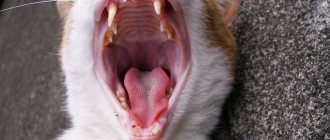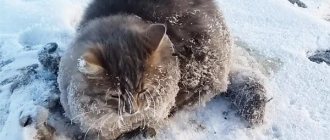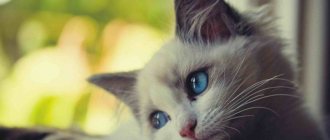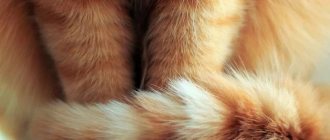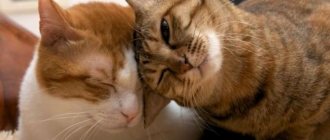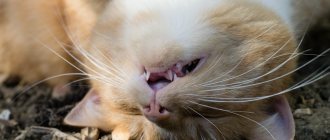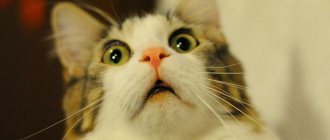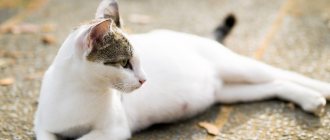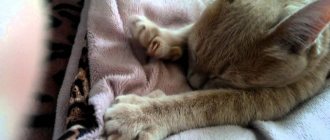Why does a cat twitch and meow in its sleep? The first thing that comes to mind for most people who observe this behavior of a pet is that the cat is dreaming. Of course, this is the simplest explanation. However, the reason why a pet is active during rest may also be the health status of the animal.
Often, the reason for twitching paws and screams is not the plot of the dream at all, but much more prosaic things, namely, illness. A reason to suspect a problem in your cat’s health is regular twitching of the limbs or their spasms.
When should you worry?
If a cat's paws twitch in its sleep, this is not always a cause for alarm. You should keep an eye on your pet. You need to observe not so much in a dream as at the moment of awakening. The state of the animal is immediately visible: if the cat is happy, she has the perky look of a hooligan or, on the contrary, the mysterious arrogant look of an empress, she stretches and yawns, purrs briefly and abruptly.
You should be concerned if your cat twitches too often during sleep. When your pet looks unhappy, tired and lethargic when waking up, you should immediately contact a veterinarian.
Doctors' help is also required in cases where a cat twitches its paws in its sleep and then wakes up sweaty and with wet fur. This is a symptom of internal problems in the body, which may be related to hormonal balance or kidney function.
Persians who eat dry food often suffer from kidney failure and urolithiasis. Persian cats prone to such ailments always first begin to twitch and sweat, and only after some time do characteristic symptoms appear - changes in the concentration, color and smell of urine.
When observing a sleeping twitching cat, you need to carefully touch it, trying not to wake the pet. This should be done in order to understand whether the animal has a spasm - contraction of muscle fibers. It is impossible to determine this visually. If your pet's body or legs are cramping, you should immediately consult a doctor.
Signs of imminent death
You can know that a cat is dying by the presence of a combination of certain symptoms. If your pet is over 12–14 years old, then you need to carefully monitor its behavior and health. Some felines live up to 25 years, but this happens very rarely.
Before you prepare for the worst, you should take him to the vet. It is likely that the pet is simply seriously ill, but it can be cured. Timely therapy is important for recovery, so do not delay going to the clinic or calling a specialist at home. For example, older cats often develop chronic pathologies that are similar to signs of impending death. However, if remission is achieved, the animal can live several more years without suffering or pain.
But even if medical intervention does not help, the doctor will advise how to properly care for your friend and prescribe medications to relieve symptoms. If you don’t have enough time to carry out supporting manipulations yourself, the cat can be placed in a clinic where he will be provided with the necessary care.
Loss of appetite is an alarming symptom
A cat's eating behavior changes dramatically before death. She eats little or refuses food at all, and then even water. The following signs should alert you:
- untouched food in a bowl;
- absence of excrement in the tray for two or more days;
- feces containing blood;
- darkening of urine.
After some time, hunger makes itself felt with sunken sides and physical exhaustion. The hair begins to fall out, the pet is no longer active and constantly lies down. Due to weakness, control over the muscles of the intestines and urinary tract is reduced. There may be traces of feces left on the floors of your home.
Difficulty breathing is a sign of the approaching end
Other symptoms of a cat dying are changes in breathing. The heart can no longer work fully, so the amount of oxygen entering the lungs and blood decreases. The pet draws in air heavily and rapidly, trying to make up for the losses. In a healthy animal, the frequency of breaths per minute is 20–30. Shortness of breath, weak or infrequent breathing are symptoms of imminent death. It is not difficult to determine the indicator; just use a stopwatch and count the number of chest rises per minute.
Decreased heart rate and blood pressure are dangerous symptoms
Signs that a cat is dying include a slowing heart rate (normally 140–122 beats per minute) and a decrease in blood pressure. Changes in these indicators occur due to difficulties in pumping blood by the heart and, as a result, overload. You can measure an animal's pulse like this:
- place your palm on the left side behind the front paw;
- count the number of beats in 15 seconds;
- calculate the heart rate per minute by multiplying the resulting figure by 4. If the number of beats is less than 60, then this sign indicates the cat’s approaching death.
Unfortunately, it is impossible to measure your pet’s blood pressure at home without special equipment.
shutterstock
A specific smell is a sign of imminent death
A dying cat emits an unpleasant odor. This happens due to a decrease in the performance of internal organs. The elimination of toxins slows down or completely stops. Harmful substances gradually accumulate in the body, a symptom of which is the unpleasant aroma of the animal’s body and mouth.
Reduced temperature
When checking for signs of death in a cat, be sure to measure its body temperature:
- a special ear thermometer;
- a rectal digital device, the tip of which is carefully inserted into the rectum.
The body temperature of a dying cat is significantly lower than 37.7 ⁰C, which indicates a weak heart. When you don’t have a thermometer at hand, you can feel the animal’s paw pads. If they are cool, then this is also a bad symptom.
What can cause twitching?
A sleeping cat may twitch for a variety of reasons. In order for the doctor to be able to narrow down the range of possible sources of this phenomenon, careful observation of the pet is required.
A cat's twitching while resting is most often caused by the following:
- neurological pathologies;
- stress;
- diseases of internal organs;
- pathogenesis of the psyche;
- inflammation of the brain;
- infection with helminths or external parasites.
The presence of muscle spasms, severe convulsions, and contraction of the limbs is always a signal of a serious illness. Unlike simple fingering and reflexive twitching of the paws, this condition is not caused by a dream or stress.
Cat dreams
It's no secret that animals can also see dreams and take an active part in them. As much as possible. They experience negative or positive emotions. Since animals are hunters by nature, experts believe that chasing or tracking prey is the main picture of the dream. In addition, representatives of the cat family experience aggression, interest, and joy. They may experience fear in their dreams of other rivals or insurmountable obstacles
A person will not look into the dream of his ward, but he can partially understand from the movements of the cat what he is dreaming. It is important to remain calm and not panic if you suddenly notice twitching of the paws or other parts of the body. It's not because of the disease
It’s just that your pet is so immersed in the dream that he takes a very direct part in it.
What causes seizures?
A cat twitches convulsively in its sleep due to the presence of an internal disease or a pathological process caused by parasites. The most common causes of seizures are:
- tumors;
- lymph inflammation;
- brain diseases;
- mental pathologies;
- deficiency of calcium or other substances;
- disturbances in the functions of the peripheral nervous system;
- infection by parasites and others.
When figuring out why cats twitch in their sleep, doctors identify specific diseases, including:
- non-purulent meningoencephalitis;
- cerebral ischemic encephalopathy;
- viral infectious peritonitis;
- toxoplasmosis;
- hyperparathyroidism;
- helminthiasis;
- ticks and fleas;
- excess medications or other drugs and additives in the blood;
- microstroke;
- lack of vitamin B;
- urolithiasis disease;
- renal failure;
- anemia.
Each of these diseases is very serious, but the most dangerous of them are meningoencephalitis, encephalopia and peritonitis.
Metabolic disorders
Failures in the functioning of internal systems disrupt metabolism and the rhythm of metabolic processes. This leads to an imbalance in the nervous system, and impulses are sent to the muscles “incorrectly,” which manifests itself in convulsions.
Metabolism-related diseases
| Name | Peculiarities |
| Eclampsia | It is observed during the period of gestation of kittens, at birth and feeding. A convulsive state develops against the background of a sharp decrease in the level of calcium in the blood and is accompanied by severe pain. In the initial stage, convulsive twitching is observed in the hind limbs. As the attacks progress, they become more frequent and affect the entire body. |
| Kidney failure | There are many factors that provoke this disease, from common infections to autoimmune pathologies. Failure of the kidneys interferes with the removal of toxins from the body. As a result, brain tissue is damaged. |
| Hypoglycemia | Blood glucose levels drop sharply. Convulsive attacks are accompanied by severe pain, causing the animal to writhe and scream loudly. This condition is similar to epileptic seizures |
| Intoxication | Toxic substances that enter a cat’s body have a negative effect on the nervous system. In mild cases, this provokes stool upset. In severe situations, intestinal bleeding is added to diarrhea. The cat is vomiting and writhing in convulsions |
Any disruption of metabolic processes if assistance is not provided in a timely manner will lead to the death of the pet.
Involuntary muscle twitching may be pre-death convulsions.
About meningoencephalitis
Non-purulent meningoencephalitis is most often diagnosed by doctors in a situation where a cat twitches in its sleep. The difference between this disease and ordinary encephalitis and classic meningitis is the absence of accumulations of pus inside the skull. The pathogenesis itself combines some processes characteristic of both diseases. This disease is an inflammation of the membranes of the brain and itself. It occurs most often in the form of complications and consequences of such ailments as:
- viral infections;
- hepatitis;
- leptospirosis;
- plague;
- ascariasis and mycosis.
In addition, the disease develops after bruises, various injuries to the skull and spine, and prolonged sepsis. Cramps during sleep are one of the earliest symptoms of this disease. But if you consult a doctor, your pet’s treatment will be successful and quickly enough.
The importance of REM sleep in kittens
Kittens are able to dream while still inside the mother cat. Moreover, REM sleep provides neural stimulation, which contributes to the normal development of the brain and the entire nervous system of the embryo. The REM phase is extremely important for newborns and growing animals. Young animals experience dreams especially vividly. Kitty:
- can move its paws;
- beat the tail on the floor;
- roll over from side to side;
- move your ears and cheek muscles;
- breathe rapidly and meow.
Especially often, such violent reactions appear after outdoor games, stress or hunting experience. Running and tired, the baby may fall asleep in an unnatural position with his eyes half-open, which also should not cause concern. Firstly, kittens are like human babies and relax in their sleep without feeling discomfort, and secondly, the presence of a third eyelid in the corner of the eye helps protect the eyeball from drying out.
Features of the nervous system in kittens. The nervous system is formed simultaneously with the growth of the body, so unusual motor activity in kittens in the REM phase is completely normal.
If in adult animals the duration of REM sleep is 15-20 minutes, followed by a longer phase of slow-wave sleep, then in kittens up to six months the REM phase takes up 80% of the total rest time.
If the owner noted that the growing furry pet began to sleep more calmly and practically does not flinch in its sleep, then we can talk about the animal growing up and strengthening the nervous system. The period of stabilization of nervous functions is very individual and is determined by many factors, such as:
- Breed affiliation. In outbred cats, which generally mature faster, psychological maturation begins by 12 months, and representatives of large breeds, growing up to 2-2.5 years, demonstrate elements of childish behavior for quite a long time.
- Character. Temperamental and easily excitable animals require more time for the development of nervous processes than balanced and calm phlegmatic animals.
- Personal negative experiences and traumas. Stress can cause serious damage to the psyche. It has been proven that animals that have experienced fear and pain can return to this episode in their sleep, experiencing real nightmares.
Also watch the video why a cat twitches in its sleep:
About encephalopathy
Cerebral ischemic encephalopathy is a softening of certain areas in the brain. The exact causes of this disease are unknown to veterinarians, and the accompanying symptoms vary significantly in different animals.
Without treatment, a pet with such a disease will inevitably degenerate completely, losing not only individual personality traits, but also basic skills. This doesn't just apply to maintaining hygiene. For example, a cat may forget how to walk or eat.
Physiological causes of trembling
Sometimes a cat trembles due to external factors such as a sudden change or decrease in the temperature of the surrounding area. Physiological factors of tremor also include stress, sexual arousal, deep sleep or some reflex processes in the animal’s body.
Cold
You will often notice that your cat will shiver after swimming or spending a long time outside on a cold day. This tremor is a mechanism of thermoregulation and does not allow the animal to freeze for a long period of time.
Pampered domestic cats get chills even with a slight drop in ambient temperature, while a pet hardened by frequent walks can stay outside for a long time, even in severe frosts. Owners should take into account such individual characteristics of their cats’ bodies to determine the duration of the walk, since hypothermia easily leads to the development of colds and inflammatory pathologies.
Emotional excitement
The cat may tremble as if it were cold when there is strong emotional arousal, positive or negative. Both during fear and during times of great joy, a large amount of certain hormones enter the animal’s bloodstream, which provoke muscle tremors.
By this sign you can determine the mood of your pet. For example, when nervous, a cat shakes as if frozen, arches its back, hisses or meows loudly. Sometimes the readiness to attack is expressed only in the shaking of the tail raised up. At the same time, sitting on the lap of its beloved owner, the animal may tremble slightly and purr with pleasure.
Sexual arousal
During the period of sexual heat, all the senses of male cats become more acute. In the absence of a sexual partner, animals are constantly nervous, strive to get out of the house, and may show aggression or excessive intrusiveness. The cat is shaking from the powerful release of sex hormones into the blood. This condition leads not only to mental disorders of the animal, but also provokes the development of malignant tumors of the reproductive organs and mammary glands. Therefore, the most humane way to get rid of the suffering of cats and female cats that do not take part in breeding is castration.
Other reasons
Some cats may experience tremors as a reflex after eating food. It is especially common to notice how a well-fed kitten trembles in its sleep and does not show signs of anxiety.
Sometimes owners have a question about why the cat trembles when he sleeps. Experts even have a special term “sleepy tremor,” which indicates maximum relaxation of all muscles.
A cat may also shiver in its sleep when sleeping indoors with low air temperatures. This is indicated by the animal’s posture - the cat curls up into a tight ball, “burying” its nose as deeply as possible into the fur or under the paw.
Poor and restless sleep, which is accompanied by periodic twitching of the limbs and tremors in the body, may be a consequence of stress or prolonged physical exertion. Most often, owners observe this condition in their pet after he “defended his rights” to a female during the period of sexual heat.
“Senile tremor” can also be considered normal. Poor circulation and innervation is the reason why an elderly cat shakes when lying or sitting in a relaxed state.
About peritonitis
Viral infectious peritonitis is in many ways similar to HIV. This is a disease that affects the cat's immune system. In a neglected state, the animal has virtually no chance of survival.
Infection with this virus occurs:
- nutritionally, that is, through objects, food, contact of the tongue with dirty human hands;
- by airborne droplets.
In the early stages, the disease is often completely asymptomatic, with the exception of only one sign - the cat twitches in its sleep. This disease is extremely dangerous. The sooner it is detected, the greater the chance that the pathogenesis can be stopped or slowed down.
The tail is an indicator of the cat's emotions
Most often, a cat twitches its tail to communicate its mood. Depending on how and how actively she begins to move it, the owner can guess what emotions his pet is experiencing:
Excess of feelings. Often a cat's tail twitches when a person pets the animal. Combined with purring, this means that the cat is absolutely happy
He is satisfied with the owner's attention and hurries to tell him about it. Interest in something
The cat's tail stands upright when the pet is happy and expects something pleasant (for example, it is time to feed). But when he begins to smoothly move it up and down, this is a sign that the cat is interested in some thing or object. He will walk around it, sniff it, try to catch it. It could be anything: a fly flying by, a new toy, a bag of groceries. Irritation. Experiencing such emotions, the cat begins to rhythmically jerk its tail left and right. This is how she shows that the current situation is unpleasant for her. For example, a pet may feel that the timing for affection is poorly chosen. Fear, panic. It is not difficult for a person to determine that a cat is very scared - the animal twitches its tail, hitting it on the floor with all its force. His whole body is shaking, his pupils are dilated, and the cat itself can make plaintive sounds. At such moments, the pet should not be touched. The best thing the owner can do is to eliminate the situation or object that frightened the animal.
Sometimes cats not only twitch their tail, but also their back. There are several reasons that cause this animal behavior. A cat constantly jerks its tail and rear part of its body in the following cases:
- during puberty she has a sexual desire, but there is no way to satisfy it;
- the animal has fleas;
- the pet has been struck by cancer - a tumor has arisen in the spinal cord or brain.
In addition, the cat may twitch its back and tail due to neurosis. In veterinary medicine it is called hyperesthesia syndrome. Suffering from this disease, the animal begins to lick its paws, back, and anus for hours. His fur becomes wet from saliva and does not have time to dry before the next wash. Such actions of the pet indicate nervous exhaustion, lack of attention from the owner, and severe stress.
According to available data and statistics, most cats regularly experience small twitches while sleeping. Some experts believe they may be similar to what people experience during REM eye movement sleep. During rapid eye movement, people dream and experience a deep sense of pleasure in sleep.
What else causes twitching?
If a cat twitches in its sleep, the reasons for this condition may be hidden in the reality around it, that is, stress may be the source of the twitching. Each animal has its own stress tolerance threshold, just like humans. Some cats are extremely emotional and very susceptible to the slightest negativity. For such animals, a rude word, inattention from the owners or being thrown aside, even a potty that is not cleaned in a timely manner and a bowl that is not washed can cause anxiety and nervous breakdown.
Siamese and Burmese are the most inclined to dramatize everything that happens around them, but Persians are cats with a stable nervous system.
Animals endowed with sociable character traits, but forced to spend the whole day locked up alone, are also prone to stress and psychological distress. For such a cat, the owner’s return from work is a great and long-awaited joy; if a person shows dissatisfaction, the animal is sincerely upset and does not understand what it has done wrong. Several such cases lead the pet to chronic stress, which subsequently develops into prolonged depression.
Why do cats snore?
In order to give correct explanations, we will touch on the anatomical structure of cats, the basics of which any owner who respects his animal should know.
The picture clearly shows how long the cat’s trachea is. Through the trachea, air enters the cat's lungs, and through it it is expelled back. In a normal state, the number of inhalations and exhalations by a cat is 17-20. A very deep breath and a very long exhale! Air is passed through the vestibule of the trachea - the larynx.
But our cats, cats and kittens do not know how to growl - the hyoid is rigidly embedded in the larynx. But our pets can purr, forcefully pushing air through this natural bony barrier. They push air as they inhale, push it as they exhale, and therefore their purring process is continuous as long as the cat keeps the larynx in a relaxed state.
Kittens begin to make these sweet sounds as early as 5-7 days after birth, as soon as their little larynx begins to harden.
This is the first reason for snoring.
Do you know that pugs snore always and everywhere? The reason for this is the brachycephalic structure of the muzzle. If your cat has the same shortened nasal passages and unnaturally altered “facial” bones, then snoring for them is a natural, standard condition, because the air moves along an anomalous trajectory. They snore even while they are awake, but during sleep, when they relax, the snoring is especially pronounced.
Snoring can also occur in the most unimaginable positions that a cat takes during sleep. This position may seem comfortable to the cat, but it blocks the natural flow of air to the lungs - disrupts their circulation. The body reacts by drawing in more air and releasing carbon dioxide back. Result: we snore, we’re shaking!
We are not talking about obesity yet, but your cat’s “legs” have already become plump, the ribs are difficult to feel under the layer of subcutaneous fat, and the scruff of the neck is almost equal in width to the butt.
If until recently your funny kitten was cheerful and cheerful, but today he has a runny nose, drooling, sneezing, diarrhea, lack of appetite and snoring, then take him by the paw and take him to Aibolit. This one sign is enough to start seeing a doctor and start proper timely treatment, which will lead to the recovery of your naughty boy.
The cause of “fading” can be anything, from helminthic infestation and diseases of the gums and teeth, to serious diseases of the heart and other internal organs.
Having dealt with the main causes of snoring, let's try to find out why your cat twitches in its sleep, runs somewhere, shudders, twitches and even fights.
What is the difference?
It is quite difficult to independently determine the difference between neurosomatic twitching and symptoms of an internal disease. The likelihood of an error is very high, therefore, if twitching of the body or limbs of a cat occurs regularly during rest, it is necessary to examine the animal.
The defining difference in the causes of twitching is considered to be the presence of a cramp. This means not only twisting of the limbs or body, in which the cat wakes up and screams, but also a slight hardening of the muscle fibers. The manifestation of emotional experiences, as a rule, is not accompanied by the appearance of stiffness in the muscles. That is, if a cat is upset and “runs around in its sleep,” its body and paws will be soft.
However, the causes of twitching are often mixed, since the sick animal perceives everything around it quite acutely.
Movements of adult animals during rest
- In (species of the older generation of individuals of the cat family, it is considered the norm to torture limbs, tail, whiskers or ears. As a rule, this happens during the transition period from adolescence. The four-legged one adapts to external changes, new living conditions and other aspects. If the cat had a day intense, it is likely that dreams will be like this.
- During adolescence, individuals strengthen their psycho-emotional environment, explore areas more deeply, build relationships with the owner and achieve stability in the nervous system. The cattle does not experience any particular stress, so sleep is calm and with periodic movement of the limbs.
- In the older generation, the last Neolithic dream is characterized by moving ears, antennae, and lips. There may also be noticeable movements of the tail and limbs. Some especially emotional individuals purr, scream or growl. Everything, again, depends on the dream.
- If the animal has passed the two-year age threshold, it can experience joy, sadness, and emotions. Some are similar in behavior to kittens; they are nervous and aggressive. In the spirit of the rule, it is more difficult for such individuals to communicate with their own kind and humans. They are withdrawn, don’t want to be around people all the time and literally huddle in their apartment.
What to do?
If your sleeping cat twitches regularly, the first thing to do is contact your veterinarians.
The immediate actions of a person during twitching determine the intensity of the manifestations and their characteristic features. If the cat continues to sleep, there is no need to wake it. In the same situations, when the animal’s muscles are cramped by a strong cramp, the pet needs to be helped - wrapped in a blanket or blanket, carried in your arms, and calmed down. In addition, you need to massage the cramped muscle. When massaging, it is important to calculate the force of your own impact so as not to hurt the animal. Often, tickling the heels with a feather or piece of paper helps with paw cramps.
An epileptic seizure deserves special attention. This condition in a cat is not always accompanied by profuse salivation, as in humans; sometimes there is no saliva. The owner’s actions in this situation should be completely similar to how they behave around people during an epileptic attack. If the animal's jaws are tightly closed, there is no need to unclench them - this can cause a fracture. The cat needs to be placed on its side and held in place, since the pounding body moves, that is, the pet can seriously hurt itself against a wall, furniture or something else. At the end of the attack, the cat should be calmed down and consult a doctor without delay.
Motor activity during sleep of an adult cat
It is normal for a cat to twitch slightly during sleep once it has passed adolescence. Adaptation of an animal in the outside world and among “its own kind”, strengthening its nervous system, completing the construction of “owner-pet” relationships contributes to its psychological stability. The cat does not experience significant stress and therefore sleeps more peacefully.
In an adult, REM sleep is accompanied by
:
- infrequent and not pronounced movements of the paws;
- twitching of the lip, mustache, ears;
- motor activity of the tail;
- rare screams, meows, growls.
If a cat older than two years old experiences emotions characteristic of a kitten in a dream, it is highly likely that it may be diagnosed with behavioral changes - increased nervousness, aggressiveness. It is difficult for such animals to adapt close to humans, and sometimes living together becomes impossible.

